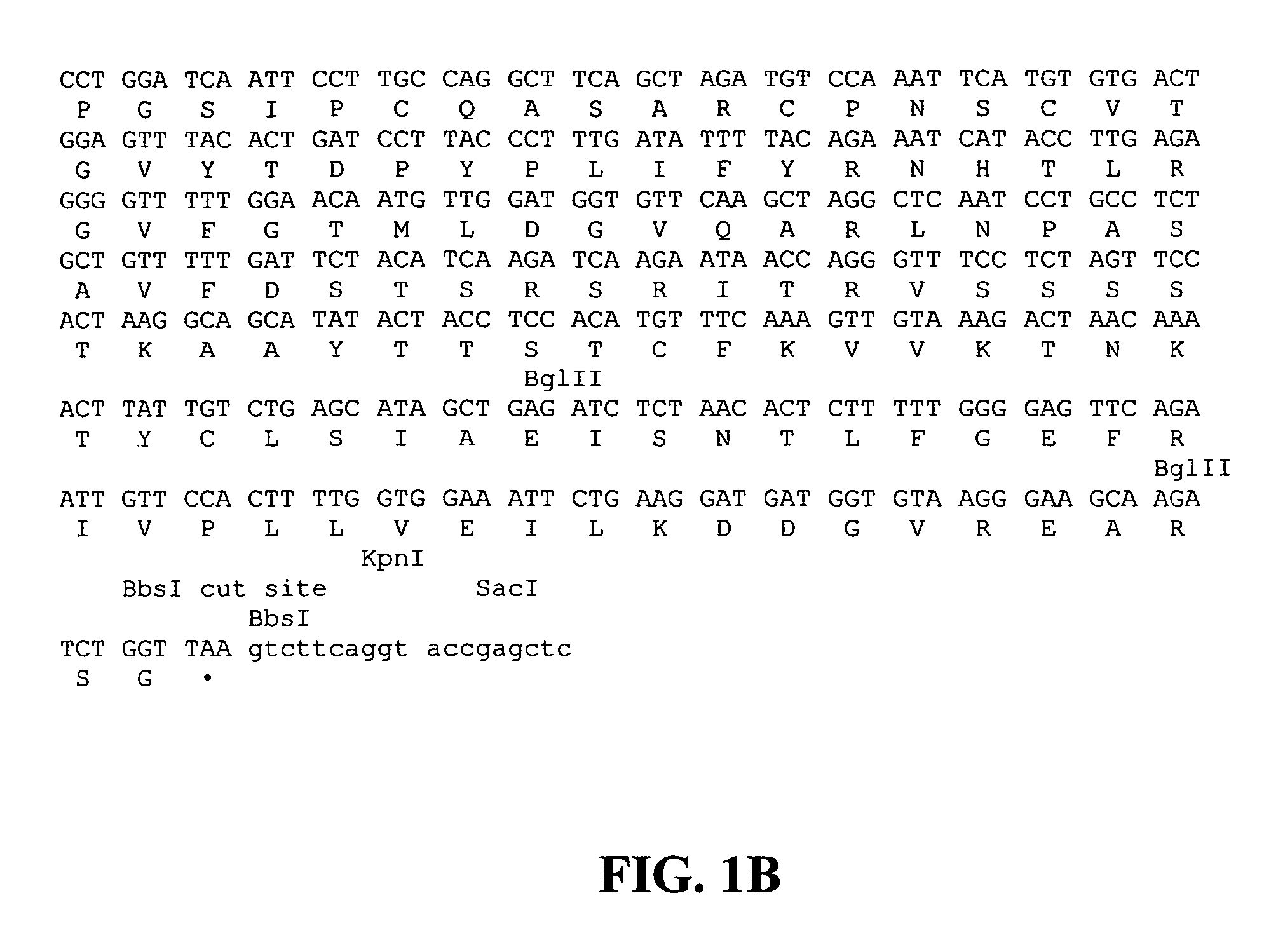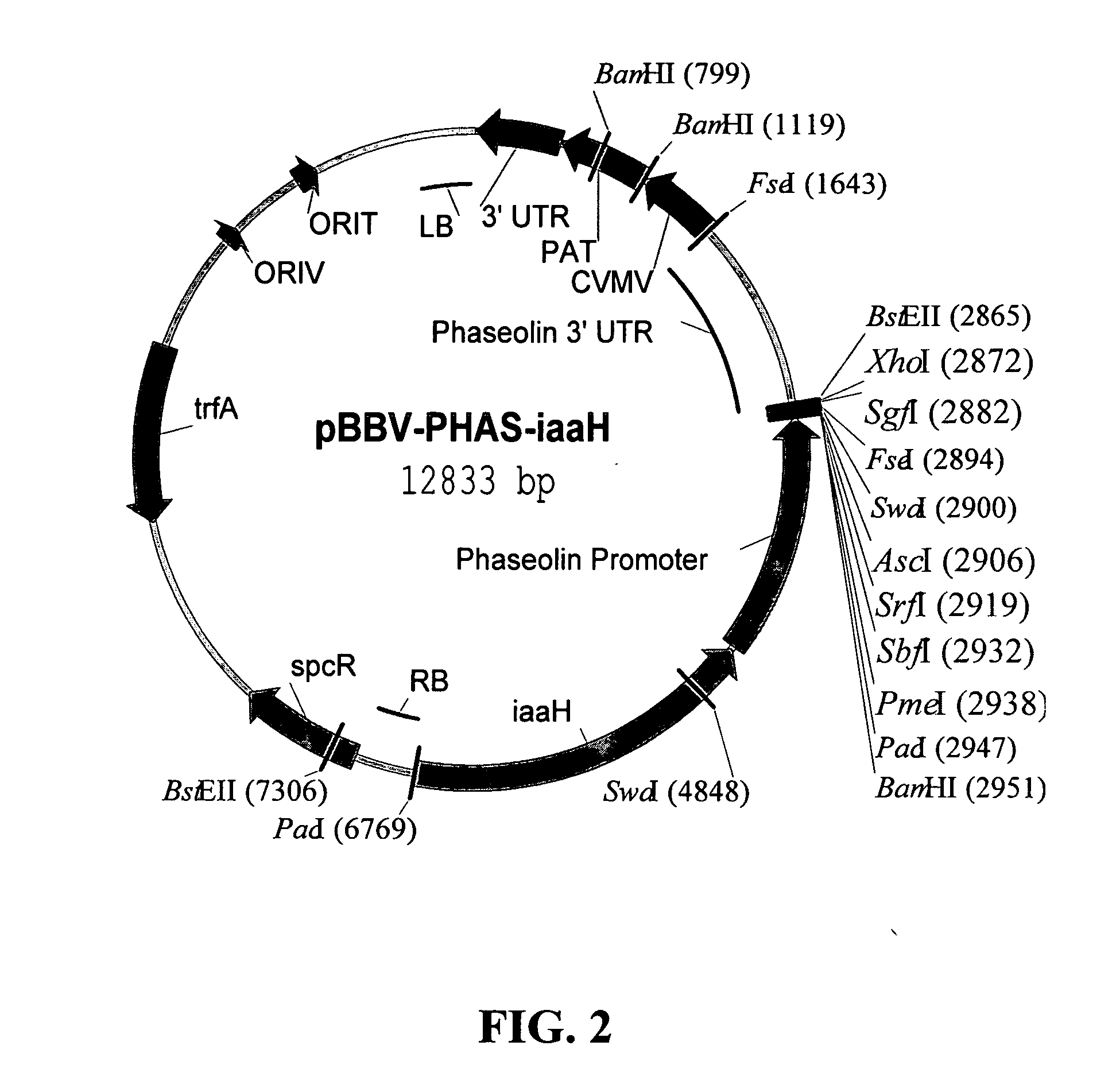Preparation of vaccine master cell lines using recombinant plant suspension cultures
a technology of plant suspension and master cell lines, which is applied in the field of plant cell culture and protein production in plant cell cultures, can solve the problems of inability to produce and purify subunit proteins produced from conventional manufacturing methods, inability to produce and purify, and inability to produ
- Summary
- Abstract
- Description
- Claims
- Application Information
AI Technical Summary
Benefits of technology
Problems solved by technology
Method used
Image
Examples
example 1
Vectors
[0073] Gene Construction: The coding sequence of the HN gene of NDV strain “Lasota” (Genbank accession AF077761), HA gene of AIV strain ATurkey / Wisconsin / 68, VP2 gene of IBDV stain E19 (GenBank accession number X00493), and LT gene of E. coli were analyzed for codon use and the presence of undesired sequence motifs that could mediate spurious mRNA processing and instability, or methylation of genomic DNA. See Adang M J, Brody M S, Cardineau G, Eagan N, Roush R T, Shewmaker C K, Jones A, Oakes J V, McBride K E (1993) The construction and expression of Bacillus thuringiensis cryIIIA gene in protoplasts and potato plants. Plant Mol Biol 21:1131-1145. A plant-optimized coding sequence was designed with hybrid codon preference reflecting tomato and potato codon usage (Ausubel F., et al., eds. (1994) Current Protocols in Molecular Biology, vol. 3, p. A.1C.3 Haq T A, Mason H S, Clements J D, Arntzen C J (1995) Oral immunization with a recombinant bacterial antigen produced in trans...
example 2
Preparation of Transgenic Nicotiana Tabacum
[0084] Three to 4 days prior to transformation, a 1 week old NT-1 culture was sub-cultured to fresh medium by adding 2 ml of the NT-1 culture into 40 ml NT-1 media. The sub-cultured was maintained in the dark at 25±1° C. on a shaker at 100 rpm.
NT-1 MediumReagentPer literMS salts 4.3 gMES stock (20×) 50 mlB1 inositol stock (100×) 10 mlMiller's I stock 3 ml2,4-D (1 mg / ml)2.21 mlSucrose 0 gpH to 5.7 ± 0.03B1 Inositol Stock (100×) (1 liter)Thiamine HCl (Vit B1)-0.1 gMES (20×) (1 liter)MES (2-N-morpholinoethanesulfonic acid)-10 gMyoinositol-10 gMiller's I (1 liter)KH2PO4-60 gMS Basal SaltsPer 1 liter DI waterModified MS vitamins (100×) 10 mlMyo-inositol 100 mgPotassium Phosphate Dibasic Anhydrous137.4 gMES 0.5 g2,4-D (10 mg / ml) 222 ulSucrose 30 gL-ProlineModified MS vitaminsPer Liter DI waterNicotinic Acid 5 mg / LPyridoxin HCL 50 mg / LThiamine HCL200 mg / LGlycine200 mg / L2.5 M L-Proline StockM.W = 115.1 grams / LPrepare 100 ml of 2.5 M Stoc...
example 3
Stability of Plant Made Proteins
[0091] Proteins extracted from recombinant or native sources are often unstable due to proteases, glycosylases, lipases or other enzymes that co-purify with the protein and cellular components. The proteins and immunoprotective particles isolated from NT-1 cells are inherently stable and are robust to many different types of down stream processing activities. In FIG. 14, CHN-18 cells were harvested from a 10 liter fermentor in stationary phase and filtered, clarified by centrifugation and microfluidized. The supernatants were then filtered through a 0.2 or 0.45 micron filter to remove any bacterial agents that may have been introduced during manipulation through filtration or microfluidization, no stabilizers were added to these suspensions, the stability is inherent to the proteins derived from these transgenic cells. The material was then stored at 2-7° C., 25° C. or frozen at −80° C.; the material was found to be stable at all temperatures, but th...
PUM
| Property | Measurement | Unit |
|---|---|---|
| Volume | aaaaa | aaaaa |
| Volume | aaaaa | aaaaa |
| Volume | aaaaa | aaaaa |
Abstract
Description
Claims
Application Information
 Login to View More
Login to View More - R&D
- Intellectual Property
- Life Sciences
- Materials
- Tech Scout
- Unparalleled Data Quality
- Higher Quality Content
- 60% Fewer Hallucinations
Browse by: Latest US Patents, China's latest patents, Technical Efficacy Thesaurus, Application Domain, Technology Topic, Popular Technical Reports.
© 2025 PatSnap. All rights reserved.Legal|Privacy policy|Modern Slavery Act Transparency Statement|Sitemap|About US| Contact US: help@patsnap.com



